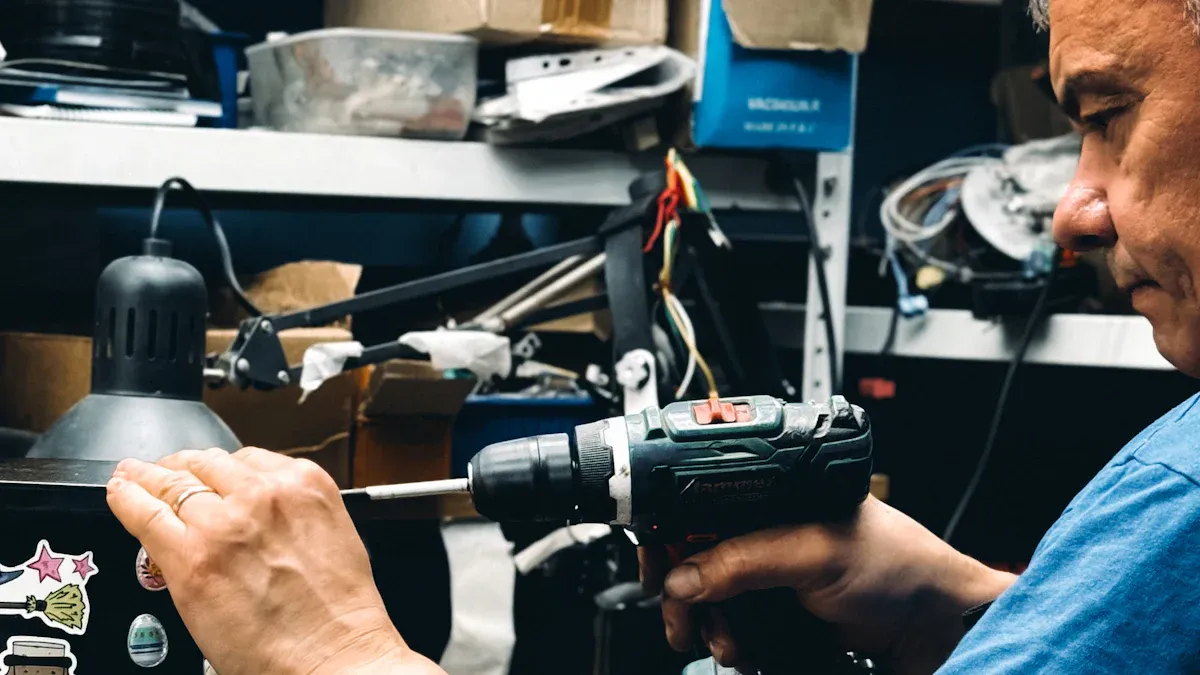Why do smt assembly workshops need anti-static measures

Static electricity is often ignored in smt assembly workshops. However, it can cause big problems. It leads to 8% to 33% of electronic issues. About 27% to 33% of these are from semiconductor problems. These issues can be very expensive to fix. Anti-static steps protect delicate parts and keep work running smoothly. This helps avoid such troubles.
Key Takeaways
Static electricity can harm parts in SMT assembly workshops. Anti-static steps protect parts and avoid expensive fixes.
Grounded desks and anti-static mats lower static electricity. Teaching workers about ESD safety makes work safer and easier.
Anti-static tools cost less in the long run. Fewer fixes and better products make customers happy and improve the company’s image.
The Risks of Static Electricity in SMT Assembly Workshops

What is static electricity and how does it occur?
Static electricity happens when an electric charge builds up on a material's surface. It forms when two materials touch and then separate, moving electrons between them. This creates an imbalance that stays until the charge is released. For example, rubbing shoes on a carpet can create static electricity. In SMT assembly workshops, this often happens as people and materials move during the process.
Grinding materials, like coffee beans, can create static charges as high as tens of nano-Coulombs per gram (nC/g). This is similar to the charges in thunderclouds or volcanic ash. In factories, finer grinding or friction increases static electricity. This can cause clumps or uneven production.
How ESD damage impacts electronic components
Electrostatic discharge (ESD) happens when built-up static electricity jumps to another object. This sudden transfer can harm delicate electronic parts. During SMT assembly, the risk is high because modern devices use tiny parts that are easily damaged by ESD.
ESD can cause different types of failures in electronics, such as:
Sparks between parts due to high voltage.
Permanent damage to circuits, making parts useless.
Hidden defects that shorten the product's life.
The cost of ESD damage is high. Studies show ESD failures lead to:
Cost Factor | Description |
|---|---|
Component Failures and Rework | Broken parts need fixing or replacing, which costs money. |
Production Delays | Stopping production for repairs causes delays and extra costs. |
Quality Control Expenses | Extra testing for ESD safety raises manufacturing costs. |
Reputation and Brand Damage | Faulty products hurt a company’s image and future sales. |
Common sources of static electricity in SMT assembly workshops
Static electricity comes from many places in SMT assembly workshops. Knowing these sources helps reduce ESD risks. Common sources include:
Personnel Movement: Walking or touching materials without grounding creates static.
Work Surfaces: Plastic or untreated mats can hold static charges.
Equipment and Tools: Machines and tools rubbing together cause static buildup.
Packaging Materials: Plastic bags and bubble wrap are big sources of static.
By spotting these sources, you can take steps to lower ESD risks and protect your parts from damage.
Why Anti-Static Measures Are Important in SMT Assembly
Keeping components safe from ESD damage
Electrostatic discharge (ESD) can harm fragile parts during SMT assembly. Static electricity builds up and releases a sudden shock, damaging sensitive components. To stop this, you need strong ESD protection. Use grounded workstations and anti-static mats to avoid static buildup.
Parts like semiconductors are very sensitive to ESD. Even tiny shocks can cause permanent damage or hidden problems. These issues make products less reliable and cost more to fix. By using anti-static materials and following ESD safety rules, you can protect your components and lower risks.
Preventing production delays and expensive repairs
Static electricity doesn’t just harm parts; it slows down production. When ESD damage happens, work stops for repairs or replacements. This causes delays and raises costs. You can prevent these problems with good ESD control.
For instance, grounding workers and tools reduces static during assembly. Training your team about ESD risks helps them follow safety steps. Anti-static mats and packaging also protect parts and keep production smooth. These actions save time and money by avoiding repairs and keeping work on track.
Meeting industry rules and standards
SMT workshops must follow strict ESD safety rules to meet industry standards. These rules ensure quality products and a safe workplace. Following them avoids fines and keeps customers happy.
Using anti-static tools and grounding methods shows you care about safety and quality. Regular training helps your team understand why ESD control matters. By following these rules, you protect parts and keep your workshop’s good reputation.
Tip: Investing in strong ESD protection not only meets rules but also makes customers trust your reliable products.
Benefits of Anti-Static Measures in SMT Assembly Workshops
Better product quality and happier customers
Anti-static steps help make products more reliable. Static electricity can harm delicate parts during assembly. Even tiny shocks can cause hidden problems or break parts completely. Using anti-static tools and following safety rules keeps parts safe. This makes products work better and last longer. Customers like products they can trust. When you meet their needs, they stay happy. Good static control not only protects parts but also builds your company’s good name.
Smoother work and safer conditions
Static electricity doesn’t just damage parts; it slows work down. Static shocks can stop production and cause delays. Anti-static tools, like grounded mats, keep work moving smoothly. These tools also make the workplace safer by stopping shocks or fires. Teaching workers about static safety helps them avoid risks. A safe and smooth workplace means better work and faster results.
Saving money over time
Anti-static tools may seem expensive, but they save money later. Stopping static damage means fewer repairs and replacements. Tools like anti-static mats and grounding wires protect parts and equipment. This also avoids delays and keeps quality high, which saves money. Over time, these tools pay for themselves. By focusing on static safety, you save money and stay ahead in the industry.
LTPCBA’s Focus on ESD Safety in SMT Assembly
Smart anti-static methods in LTPCBA’s workshops
Protecting delicate parts during SMT assembly needs strong ESD safety. LTPCBA uses smart anti-static methods to stop static electricity from causing harm. These methods cover all steps, from handling materials to packing products.
Static-free floors are a big part of LTPCBA’s workshops. Special grounding systems stop static shocks from happening. Workstations have anti-static mats and tools to lower static buildup. Workers are trained to handle sensitive parts carefully and safely.
As technology changes, LTPCBA keeps improving its ESD safety measures. They adjust their methods to meet new needs. For example, a Japanese company cut ESD damage from 0.12% to 0.003% with three-level protections. LTPCBA follows similar ideas, keeping grounding resistance low for safety and reliability.
How LTPCBA meets ESD safety rules
You can count on LTPCBA to follow ESD safety rules. They stick to global standards like ISO and UL certifications. Their structured safety steps lower risks and ensure compliance.
Static electricity can harm delicate parts. LTPCBA uses anti-static tools and grounding systems to control static shocks. Regular checks and worker training help them stay on track. By focusing on safety, LTPCBA delivers reliable products you can trust.
LTPCBA’s quality checks to stop ESD damage
Quality checks are key to LTPCBA’s ESD safety plan. They use advanced tests to find and fix static problems early. Anti-static tools and static-free floors protect parts during every step.
LTPCBA also trains workers to prevent static shocks and handle parts with care. This careful approach reduces damage and ensures dependable products. By focusing on quality, LTPCBA earns trust and delivers great results.
Static electricity can cause big problems in SMT workshops. Using the right anti-static steps helps avoid these issues. These measures keep parts safe, make products better, and speed up work. LTPCBA’s strong ESD safety methods and focus on quality make them a trusted choice for top-notch PCB assembly services.
Tip: Check out LTPCBA to explore their ESD-safe solutions!
FAQ
How can you stop static electricity in SMT workshops?
Use grounded tools, anti-static mats, and train workers well. These steps lower static buildup and shield delicate parts from ESD.
How often should anti-static tools be checked?
Check grounding systems and anti-static tools every month. Regular checks keep them working and prevent surprise ESD problems during assembly.
Why does worker training matter for ESD safety?
Training shows workers how to handle parts safely and follow rules. A trained team lowers ESD risks and makes products more reliable.
Tip: Focus on ESD safety to keep quality high and customers happy.
See Also
Impact of Static Electricity on SMT Production Processes
Meeting SMT Assembly Standards for Automotive Manufacturing
Key Technical Aspects of Wave Soldering in DIP Assembly
